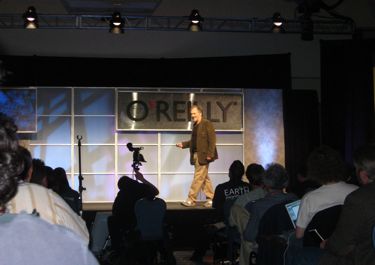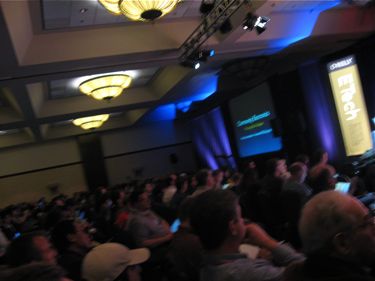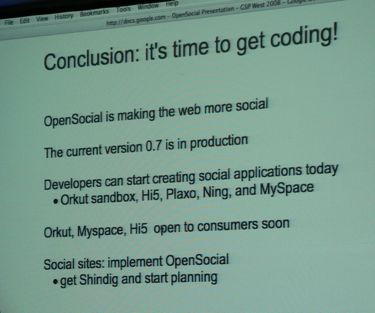As a followup to my previous blog posts and innumerable Twitters (starting on March3) about the Graphing Social Patterns and ETech conferences this past week, I just wanted to say-hey to all those I met or ran into — at least those I got cards from. It was fun chatting with all of you, and I look forward to staying in touch! After all, we’re supposed to be "social" at these things, right? In fact, please Facebook me and/or hook up with me on LinkedIn (see links just to the right in my sidebar), if we aren’t already connected (or I will do that from my end). 
Hello again to the following folks I already knew and ran into at GSP or ETech (listed alphabetically):
•Sean Ammirati, VP at mSpoke and ReadWriteWeb contributor (PA)
•Dan Carroll, CEO, Intelligent Media Platform and Somr.org (formerly Minneapolis, now Mountain View)
•Rick Enrico, CEO, JuiceMedia (San Diego)
•Aaron Fulkerson, Cofounder, Mindtouch (San Diego)
•Chris Gammill, Web Product Marketing Consultant (LA)
•Dan Grigsby, uber-developer, Unpossible.com (MN)
•Alex Iskold, CEO of AdaptiveBlue and ReadWriteWeb contributor (NJ)
•Jeremiah Owyang, new Forrester Research analyst rockstar (SF) 
And it was great meeting all these new people (listed alphabetically); apologies to those I may have missed because I didn’t get a card:
•Bill Binning, CMO, Jaduka (TX)
•Ben Benner, CTO, Jaduka (TX)
•Derek Dukes, Founder, Dipity (SF)
•Pete Forde, Partner, Unspace (Toronto)
•Chris Hendricks, VP Bus Dev, Travature (San Diego)
•Kristofer Layon, Web Project Coord, U of MN (Go, Gophers!)
•Ian Kennedy, Product Mgr, MyBlogLog/Yahoo (SF)
•Sanyu Kirulata, Queen’s School of Business MBA candidate (Canada)
•Vince Kohli, CEO, BizInnovativ (NJ)
•Chris Messina, Citizen Agency/DISO-project.org (SF)
•David Recordon, Open Platforms Technical Lead, SixApart (SF)
•Jodee Rich, CEO, PeopleBrowsr.com (Sydney)
•Jeff Roberto, Marketing/PR Director, Friendster (SF)
•Jason Rubenstein, Cofounder, Just Three Words (LA)
•Todd Sampson, Cofounder and Dir-Tech Mktg, MyBlogLog/Yahoo (SF)
•Maria Sipka, CEO, Linqia (Spain via Sydney)…and she surfs, too!
I hope those of you who read this will let me know what you thought of the events (just email me at graeme at thickins dot com). Best of luck to all of you in your current endeavors! And I certainly hope our respective social graphs continue to intersect in good ways….

[By the way, if you’d like to get access to any speaker presentation files from either event, they’re being posted on the following pages, which the O’Reilly people said are being updated as speakers choose to add their slides:
– GSP speaker presentations (this is the specific page at Slideshare.net where speakers were asked to post their slides)
– ETech speaker presentations (a page on the O’Reilly site that has several postings already, and I assume more will be added ongoing).
Keep checking these links if you don’t see what you want.]
UPDATE 3/10/08: To update link for GSP speaker presentations.
UPDATE 3/17/08: To give you yet another link to the GSP presentations, this one the official O’Reilly page, which recently went live: Graphing Social Patterns West 2008 – Presentation Files.
 Webb asked the question, “How do we design for this generation?” Though he’s a product designer himself, he went on to say later that Generation C is capable of building products of their own, being so into social networks and mashups and things — so one wonders then why we need product designers? But that’s just the pixel side of the equation. We still need people with design sense to help us sculpt things made out atoms — plastic or whatever. Products are getting smarter and more social, with all kinds of networking capabilities, of course. And we have “new paradigms for interaction,” said Webb. He cited widgets, for example, which he said is such a great paradigm, “it shouldn’t be limited to just the desktop and web.” A key point Webb made is that experience is what counts to this generation, and “how do we design for experience?” He said in his wrapup that experience should be “treated as a design surface,” and that all of us in the room are the right people to address these new design challenges. One nice thing the O’Reilly people pointed out to us in the description of this session was that “people have been paying for plastic longer than pixels.” So, the business model is there! 🙂 It should be an exciting future for product designers, whoever they may be.
Webb asked the question, “How do we design for this generation?” Though he’s a product designer himself, he went on to say later that Generation C is capable of building products of their own, being so into social networks and mashups and things — so one wonders then why we need product designers? But that’s just the pixel side of the equation. We still need people with design sense to help us sculpt things made out atoms — plastic or whatever. Products are getting smarter and more social, with all kinds of networking capabilities, of course. And we have “new paradigms for interaction,” said Webb. He cited widgets, for example, which he said is such a great paradigm, “it shouldn’t be limited to just the desktop and web.” A key point Webb made is that experience is what counts to this generation, and “how do we design for experience?” He said in his wrapup that experience should be “treated as a design surface,” and that all of us in the room are the right people to address these new design challenges. One nice thing the O’Reilly people pointed out to us in the description of this session was that “people have been paying for plastic longer than pixels.” So, the business model is there! 🙂 It should be an exciting future for product designers, whoever they may be. Similarly, games are made up of games — lots of little ones are in any good game, he said. Building games is about good “interaction design.” Then he ran us through a quick lesson in designing for fun, or applying game design to, for example, social media applications. He said you should have statistical features and opportunities for competition. “Never start an interaction with no context,” he said. And the participant must be able to prepare for the next encounter. Users should be able to solve challenges with a choice of tools, he said. “Reward them with different feedback. Variable feedback keeps things lively. And it should be visible to everyone.” Raph closed by telling us to check out his book site for more:
Similarly, games are made up of games — lots of little ones are in any good game, he said. Building games is about good “interaction design.” Then he ran us through a quick lesson in designing for fun, or applying game design to, for example, social media applications. He said you should have statistical features and opportunities for competition. “Never start an interaction with no context,” he said. And the participant must be able to prepare for the next encounter. Users should be able to solve challenges with a choice of tools, he said. “Reward them with different feedback. Variable feedback keeps things lively. And it should be visible to everyone.” Raph closed by telling us to check out his book site for more:  Magic is a good metaphor, “a useful abstraction … because it does not cripple — it explains.” Magic to him is about the interaction you have with an object.
Magic is a good metaphor, “a useful abstraction … because it does not cripple — it explains.” Magic to him is about the interaction you have with an object. 
Recent Comments